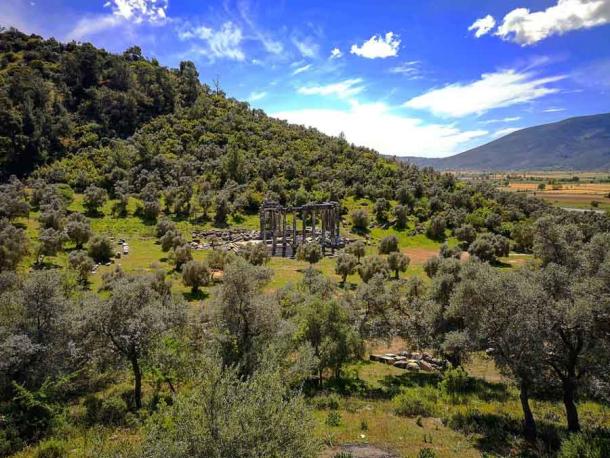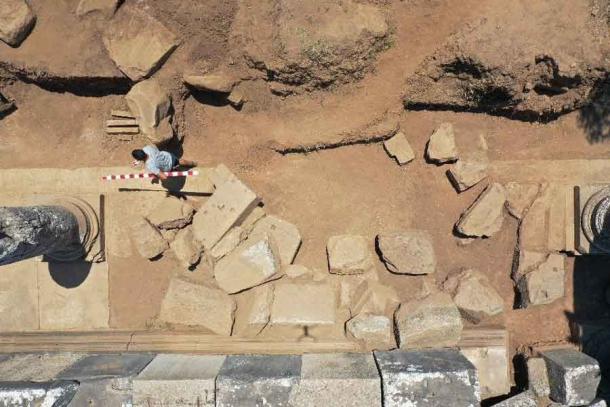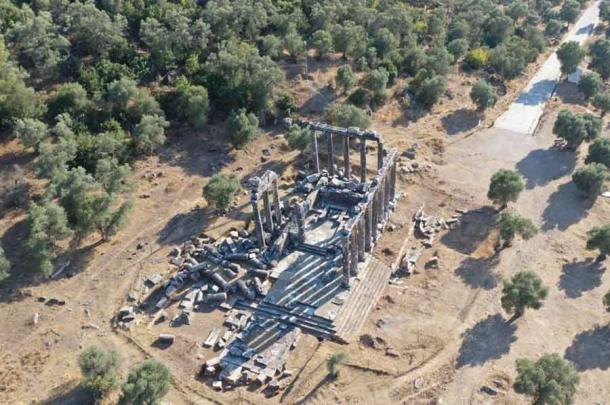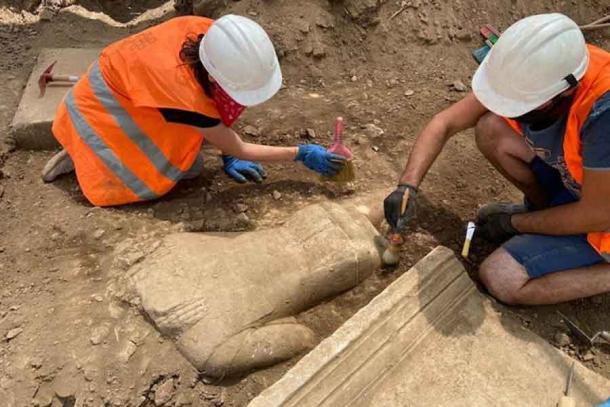
Discovery of Kouros Statues Puts Euromos Temple of Zeus Lepsynos on the Map
Archaeologists working in the province of Muğla, Turkey are celebrating an exciting archaeological find. During routine excavations and restoration work at the Temple of Zeus Lepsynos in the ancient city of Euromos in Turkey they have unearthed a pair of 2,500-year-old marble statues. Known as kouros, the statues were not found alone. They were discovered along with an ancient Hellenistic-era inscription. The team hopes that these new artifacts will help to highlight the importance of the site and aid in uncovering her secrets.

The ruins of the Temple of Zeus Lepsynos in the ancient city of Euromos in Turkey. (Gargarapalvin / CC BY 4.0)
Excavations at Euromos and its Temple of Zeus
Excavations at Euromos are not new. They began in 1969 under Ümit Serdaroğlu and continued until 1975. After almost 4 decades, they restarted in 2011 under the direction of Abuzer Kizil from Muğla Sıtkı Kocman University's Department of Archaeology working with the Turkish Ministry of Culture and Tourism. Much of the area remains unexcavated even today, but the team continues to work to uncover the history of the ancient city, periodically announcing new finds.
In 2016, the Archaeology News Network reported that Kızıl and his team had been carrying out “cleaning, drilling, geophysical, mapping, culvert and excavation works” for several years, focusing particularly on the Temple of Zeus. “We enumerate each of thousands of pieces… one by one,” highlighted Kizil when describing the painstaking work.
- Corporate Terrorists Strike Roman Temple in Turkey
- Which Goddess Lost Her Legs in a Shipwreck? 2,700-Year-Old Terracotta Statue Discovered in Turkish Waters
Originally known as Cyramos, the city was located within the region called Caria. In the 4th century BC it lost its independence and was made subordinate to the city of Milas during the time of King Mausolus of Halicarnassus. As part of Mausolus’ Hellenization efforts, the city was named Euromos, which means “strong”. The city was then granted some form of independence as an autonomous city under the Romans.
Nevertheless, the life of Euromos was suddenly cut short by what archaeologists believe was the Antonine Plague. This ancient pandemic, which historians believe was either measles or smallpox, took place during the time of Marcus Aurelius, and spread across the Roman Empire, including the area once known as Asia Minor, thanks to the Roman Army returning from Asia. Starting in 165 AD, historians claim it killed as many as 2,000 people per day in ancient Rome, with estimates reaching a total of 5 million victims before it abated in 180 AD. Euromos was left completely abandoned.
These days, adventurous visitors can find the ruins hidden in the stunning landscape off the Söke-Milas road. Best known for its Temple of Zeus, archaeologists have also found the remains of a theater, an agora, the city walls, and even a necropolis. Part of the charm of the site is that it is not fenced, there is no infrastructure catering to tourists and the ruins dotting the landscape are covered in foliage giving it an off-the-beaten-path feel.

Excavation work by the Temple of Zeus Lepsynos at the ancient city of Euromos in Turkey. (Anadolu Agency)
Amazingly Well-Preserved Temple of Zeus
The Temple of Zeus Lepsynos at the Euromos site is “one of the best-preserved Roman temples of Asia Minor,” reports the Archaeology News Network. It was built in the 2nd century AD within the city of Euromos, though archaeologists believe that the temple was never actually completed due to the fact that not all of the columns were fluted. Even so, this is one of the most important structures found to date at Euromos and there are plans to restore it.
Archaeologists believe that there was already a temple to Zeus in the 5th century BC. Turkish Archaeological News argues that this could have been in part due to the Hellenization of this part of Asia Minor as the Greeks replaced the “local, mostly female Anatolian deities, with the gods of the Greek pantheon.”

Aerial view of the Temple of Zeus Lepsynos at Euromos. (Anadolu Agency)
The temple whose remains are visible today, hidden amongst a forest of olive trees, dates back to the time of Hadrian. The rectangular peripteros structure is decorated by 11 columns on the longer sides and six on the shorter sides. Of these, 16 columns are still standing today. What makes these columns all the more spectacular is that they are inscribed with the names of their sponsors: Menekrates the doctor and Leo Quintus the bureaucrat amongst them.
On the eastern side of the Temple of Zeus the archaeological team has also uncovered the vestiges of an altar whose inscription states it was a temple dedicated to Zeus Lepsynos. If you’re wondering what “Lepsynos” means, this remains a mystery even today. Notwithstanding, “this is one of Anatolia’s best preserved temples of the Roman period,” highlighted Abuzer Kızıl in Anadolu Agency.

The surprising discovery of one of the statues at the Temple of Zeus in Muğla, Turkey. (Anadolu Agency)
Unearthing Kouroi Statues at Temple of Zeus
According to Anadolu Agency (AA), the discovery “came as a surprise to the world of archaeology” when the team “unexpectedly” unearthed the ancient sculptures, measuring about 110 cm (43 inches) each. Both sculptures have been categorized as kouros, a term used to describe a free-standing ancient Greek sculpture which usually depicted nude male youths. "We have unearthed two very important links of the missing Archaic sculpture of the Carian region,” stressed Kızıl.
While one of the 2,500-year-old kouroi was naked, the other one unearthed at Euromos was discovered wearing a chiton (an ancient Greek tunic) and leather armor. Once painstakingly excavated from the ground, both of the statues were found to be holding a lion in their hands. “Iconographically, the lion holds great significance... and is likely associated with the god Apollo,” hypothesized Kızıl in the Archaeology News Network.
- Would You Like to Own an Archaeological Site in Turkey? For $8.3 Million You Can
- Kritios Boy: Damaged by the Persians, Buried for 2,400 Years, Resurrected for the World to See
The team is hoping that the inscription, which was also found at the site, will hold clues as to the history of Euromos. While they know it dates back to the Hellenistic era, they are still trying to decipher its message. Meanwhile, locals hope that these artifacts and the continued work at Euromos will help to promote the region as a destination for much-needed tourism. “The Temple of Zeus will take its rightful place,” said Abuzer Kizil, who has argued that it should be included as a UNESCO World Heritage site. “It will be one of the best, most interesting and most-popular temples in Anatolia.”
Top image: Archaeologists excavating the kouros statues at the Temple of Zeus in Euromos. Source: Anadolu Agency
By Cecilia Bogaard















